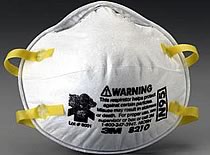Have you had the experience when hiking of shifting your way-too-heavy pack a bit and it feels better for a while? I feel like doing that just now. Enough with the hopelessness of getting real health care reform during our one opportunity in a generation. Enough with so-called Democrats, whether they’re warming chairs in the Oval Office or on Capitol Hill. Let’s talk about swine flu, and, specifically, face masks. Should you or should you not stock up on face masks?

The CDC–. Wait, I’ll start over. Even if you feel the government is not your friend, the CDC really does know about face masks. Honest. The CDC [1] starts the discussion at what are known as N95 masks. These are rated to stop 95% of airborne particles and droplets that are larger than 0.3 microns in size. As you can see in the picture, these are reasonably formidable, thick, stuffy-to-breathe-through face masks.
The good news is that aerosolized droplets exhaled or sneezed out are mostly larger than 0.5 microns [2]. The bad news is that if the particle floats long enough to evaporate the associated water, a “naked” flu virus is on the order of 100 nanometers. That’s 0.1 microns. Now, a bare virus doesn’t survive, but if it retains, say, half its water droplet, it might well be smaller than 0.3 microns. In other words, it’ll pass through the mask as easily as you can pass through a doorway.
Note that I’m not even addressing the issue of the space between the mask and your face. This is all assuming you have a perfect fit with no gaps which are, say a tenth of a millimeter big. A tenth of a millimeter is 100 microns. Picture how big that looks to a 0.5 micron droplet.
You see where I’m headed with this. An N95 mask is useful when worn by the sick person, when droplets are at their full, unevaporated size. It’ll do very little to stop a healthy person from breathing in viruses.
CDC … Recommendations for Facemask… Use to Reduce … Virus Transmission [1]
Facemasks cleared by the FDA for use as medical devices have been determined to have specific levels of protection from penetration of blood and body fluids. Facemasks help stop droplets from being spread by the person wearing them. They also keep splashes or sprays from reaching the mouth and nose of the person wearing the facemask. They are not designed to protect against breathing in very small particle aerosols that may contain viruses. Facemasks should be used once and then thrown away in the trash. (emphasis mine)
One important point is the bit about “keep [crud] from reaching the nose or mouth.” A major method of transmission for both colds and flu is virus particles on the fingers which are then touched to the nose, mouth, or eyes. Masks are excellent at preventing you from touching your nose or mouth, so they do indeed cut down on transmission to a healthy person. But not for the reason most people think. You could wear a bandanna like a bandit and get the same type of protection.
[Off-topic, but it can’t be repeated often enough: do NOT take antivirals preventively when you’re healthy (unless you’re told to do so as a public health measure). Viruses evolve incredibly fast, in a matter of weeks. Resistance to tamiflu is already building up in H1N1 swine flu virus. Taking it when you’re healthy helps the virus get resistant. You do not want to help the virus. Really. Once there are resistant strains, you too can catch them, and then all the tamiflu in the world won’t do a thing for you. Do not stock up on tamiflu. Just don’t.]
So, to answer the question, yes, by all means, stock up on some real, N95-rated, face masks. Use them if you get sick. Also: stay home. Don’t spread it around. If you can’t stay home because you have an idiot boss, wear an N95 face mask and let everyone know you’re sick.
To stay healthy the best measures are:
- Wash hands frequently with soap and water or use alcohol-based hand cleaner when soap and water are not available.
- Avoid touching your eyes, nose and mouth
- Avoid close contact (i.e. being within about 6 feet) with persons with ILI.
swine flu, H1N1, face masks